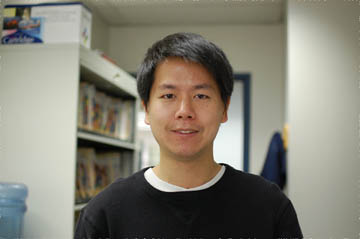Chih King

Email:
chking@mail.med.upenn.edu
Telephone:
215-898-0181 (lab)
Fax:
215-573-4454
Biographical Sketch
I grew up in Salem, Oregon, and in order to move to a place with less rain I went to the University of Iowa where I graduated in 2003 with a BA in economics. During college I was involved in several research projects, including a study of Multi-Agent System and its applications on Game Theory, helping to design programs and to construct a multi-core supercomputer in order to simulate demand-and-supply systems and economics models, as well as doing an honors research thesis on the pharamaceutical spending in the U.S. I was also able to analyze the relationship between Drosophila simulans and Wolbachia pipientis as a Howard Hughes Undergraduate Research Fellow. Following graduation I entered the MD program at the University of Pittsburgh, where at Dr. Robert Bowser’s lab I had a chance gain further research experience by trying to identify protein alterations in G39A SOD1 transgenic mice plasma that are unique to ALS pathogenesis. After two years of medical school I felt a need to further augment my medical training with research experience in neuroscience, so I decided take a leave of absence from medical school to enroll in the PhD program at the University of Pennsylvania. After several research rotations I decided that Dr. Steven Scherer’s lab fits my research interest the closest.
Current Projects
In brief, currently I have two research focuses in the Scherer lab, both centered on the KCNQ family of potassium channels, which is a subtype of the slowly activating channels that are responsible for the M-current. Since the KCNQ channels are thought to play a role in maintaining normal membrane resting potential, mutation of these channels can lead to abnormal neuronal activity. Currently there are five known KCNQ channels – KCNQ1 to 5. My first research focus is on the KCNQ5 channel. In this project I am trying to ascertain the expression pattern of KCNQ5 channel in the CNS and the PNS, and more importantly, whether KCNQ5 channels are expressed by the unmyelinated and/or the myelinated sensory neurons. I am currently using multiple techniques to examine the expression pattern of KCNQ5, and I hope to have the results soon.
The other research focus that I have in the Scherer lab is on the role of KCNQ2 on neuronal activity. In order to achieve this I am using the cre-lox system to generate conditional knockout KCNQ2 mice in the sensory neurons (since a straight knockout will kill the animal). Thus far I have crossed multiple cre lines to our KCNQ2-floxed mice, and I plan to generate the conditional knockout animal with the most specific and efficacious cre line. After the generation of the conditionally knockout mice I will analyze the function of the KCNQ2 with electrophysiology.

